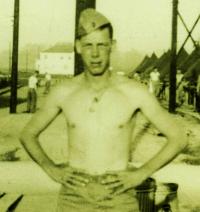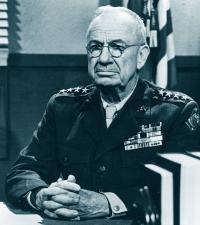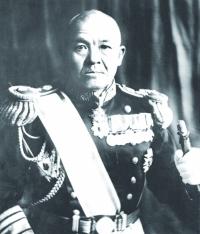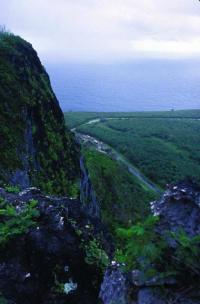
Wartime photo of Lee Marvin.

Lee Marvin with Oscar.

Holland McTyeire "Howlin' Mad" Smith, Cmdr. V Amphibious Corps which captured Saipan.

Vice Admiral Chuichi Nagumo

Suicide Cliff
The invasion of Saipan never received its deserved notoriety as one of the most important invasions of World War II. Saipan lies in the Northern Marianas Islands, site of the “Great Marianas Turkey Shoot,” where Japanese Air power was devastated. During what is known as the Battle of the Philippine Sea, 600 plus Japanese aircraft were shot down, of the approximately 750 aircraft that participated. Task Force 58, commanded by Vice Admiral Raymond Spruence, turned back an approaching Japanese Naval Force from the southeast, leaving the 30,000 Japanese soldiers without re-supply or reinforcement on the island.
Saipan’s importance lay in the fact the Japanese had built airfields on the island. If captured the Allied Forces could launch B-29 Super Fortress bombers to the Home Islands of Japan. This would effectively lead to the end of the war with Japan.
The invasion produced horrors that American combat soldiers had never seen before in the war. The citizens of Saipan were indoctrinated into the belief the invading soldiers would rape all the women, kill the children, and kill everyone on the island. When the invasion commenced and American forces gained a foothold on the island, thousands of civilians were seen committing suicide by jumping off the numerous cliffs, some with their children in their arms, others being pushed off by Japanese soldiers, while still more hid in caves and drainage tunnels detonating hand grenades on themselves. Interpreters were brought in to try and convince the population over loudspeakers they were in no danger from the Americans, but despite these efforts 22,000 civilians committed suicide.
The defense of Saipan was to be one of no surrender. The Japanese forces were led by Vice-Admiral Chuichi Nagumo, who led the carrier force that attacked Pearl Harbor and lost the Battle of Midway. He ultimately committed suicide when Saipan was lost.
Meanwhile, the Japanese War Ministry, seeing the eventual loss of Saipan, began preparing the Japanese population, young and old, women and children, to prepare for battle against the invasion of the Japanese Home Islands. Much like the D-day Invasion being the beginning of the end for Nazi Germany, the invasion of Saipan was the beginning of the end of the Japanese Empire.
On June 13, 1944, 15 battleships firing 165,000 rounds began their barrage of Saipan at 0700. Nearly 300 landing craft began delivering 8000 Marines to the western shores of Saipan. The Japanese, in preparation for the pending invasion, had established defenses they felt would inflict the maximum amount of casualties to the Allies. Flags were planted in the lagoons at known distances from their artillery for maximum effect. Land mines, barbed wire, and machine gun emplacements were strategically placed as well. By nightfall, Marines of the 2nd and 4th Divisions had established a beachhead six miles long and half-mile deep. On the first night the Japanese counterattacked, but were turned back with heavy losses.
On June 16, the 27th US Army Infantry Division, from New York, landed on the island and proceeded to present day Saipan International Airport. Once again, after dark the Japanese attacked and were driven back with heavy losses. Lieutenant General Yoshistugu Saito, commanding the 43rd Japanese Division, abandoned the airfield. Since their loss of three Aircraft Carriers and hundreds of planes during the Battle of the Philippine Sea, there was no hope of reinforcements or resupply. The 30,000 Japanese soldiers were ordered to fight to the last man.
Lt. General Saito distributed his troops across Mt. Tapotchau, a mountainous area on central Saipan. These areas were nicknamed by American troops as Purple Heart Ridge, Hell's Pocket, and Death Valley. Hiding and fighting from caves in the daytime, and using sorties at night, the Japanese inflicted heavy casualties. However, American troops using artillery, flamethrowers, and machine guns managed to neutralize the Japanese defense.
By July 7, the forces of Imperial Japan had no place to go and Saito made plans for a final Banzai charge. At dawn a group of 12 men carrying large red flags rallied 3000 men to the final charge. Amazingly, wounded men with bandaged heads, crutches and lightly armed fell in, joining the attack. The Japanese surged over the American lines. The 1st and 2nd Battalions of the 105th Infantry Regiment were nearly destroyed with 650 killed and wounded. However, after the 15-hour battle, with the assistance of supply elements of the 3rd Battalion, 10th Marine Artillery Regiment, 4,300 Japanese were killed. Three members of the 105th were awarded the Medal of Honor Posthumously in their participation in the largest Banzai attack of the Pacific War. At 1615, July 9, the Island of Saipan was declared secure. Saito, along with Commanders Hirakushi, Igeta, and Vice-Admiral Nagumo committed suicide. 2,949 Americans were killed,10,464 were wounded of the 71,000 that landed. PFC Lee Marvin, "I" Company 24th Marine Regiment, was wounded by enemy machine gun fire and was awarded the Purple Heart and a Medical Discharge, the same American Movie Actor of that name.
FOOTNOTE: In August 2014, members of a Japanese Archeological Team searching Saipan for information and artifacts from the war found a mass grave inside a cave on the island. They found a GI Dog Tag from PFC Bernard Gavrin. After 70 years, PFC Gavrin, who was reported Missing in Action in the Invasion of Saipan, can come home.
NEXT WEEK: THE BATTLE OF THE PHILIPPINE SEA
«Go back to the previous page.




